Radioactive Contaminants in Edible Mushrooms: A Comparative Study of 137Cs and Natural Radionuclides in Amasya and Tekirdağ, Türkiye
Abstract
1. Introduction
2. Materials and Methods
2.1. Study Areas
2.2. Sampling and Sample Preparation
2.3. Preparation of Mushroom Samples and Determination of Radioactivity Content
3. Results
3.1. Radionuclide Activity Concentrations in Tekirdağ Samples
3.2. Radionuclide Activity Concentrations in Amasya Samples
3.3. Comparison of Common Species
3.4. Additional Radionuclides and Visual Representations
3.5. Comparison with International Studies on 137Cs in Mushrooms
4. Discussion
4.1. 40K and 137Cs in Tekirdağ Versus Amasya
4.2. Interregional Comparisons of Common Species
4.3. Detailed Observations on 137Cs, 232Th, and 238U
4.4. 40K Accumulation and Homeostasis
4.5. Comparisons with Other Regions and the “Chernobyl Fallout” Map
4.6. Concluding Remarks
5. Conclusions
Author Contributions
Funding
Institutional Review Board Statement
Informed Consent Statement
Data Availability Statement
Acknowledgments
Conflicts of Interest
References
- Pekşen, A.; Kibar, B. Yenilebilir Ektomikorizal Mantarlarin Yetiştiriciliği ve bu Konuda Yapilan Çalişmalar. Anadolu Tarım Bilim. Derg. 2007, 22, 239–247. [Google Scholar]
- de Castro, L.P.; Maihara, V.A.; Silva, P.S.C.; Figueira, R.C.L. Artificial and Natural Radioactivity in Edible Mushrooms from Sao Paulo, Brazil. J. Environ. Radioact. 2012, 113, 150–154. [Google Scholar] [CrossRef] [PubMed]
- Guillén, J.; Baeza, A. Radioactivity in Mushrooms: A Health Hazard? Food Chem. 2014, 154, 14–25. [Google Scholar] [CrossRef] [PubMed]
- Voces, R.; Diaz-Balteiro, L.; Alfranca, Ó. Demand for Wild Edible Mushrooms. The Case of Lactarius Deliciosus in Barcelona (Spain). J. Econ. 2012, 18, 47–60. [Google Scholar] [CrossRef]
- Bucurica, I.A.; Dulama, I.D.; Radulescu, C.; Banica, A.L.; Stanescu, S.G. Heavy Metals and Associated Risks of Wild Edible Mushrooms Consumption: Transfer Factor, Carcinogenic Risk, and Health Risk Index. J. Fungi 2024, 10, 844. [Google Scholar] [CrossRef]
- Rühm, W.; Kammerer, L.; Hiersche, L.; Wirth, E. The 137Cs134Cs Ratio in Fungi as an Indicator of the Major Mycelium Location in Forest Soil. J. Environ. Radioact. 1997, 35, 129–148. [Google Scholar] [CrossRef]
- Rosa, M.M.L.; Maihara, V.A.; Taddei, M.H.T.; Silva, M.A.; Ferreira, M.T. Determination of 228Th, 232Th, And 228Ra in Wild Mushroom from a Naturally High Radioactive region in Brazil. In Proceedings of the 2011 International Nuclear Atlantic Conference—INAC, Belo Horizonte, MG, Brazil, 24–28 October 2011. [Google Scholar]
- Yilmaz, A.; Yıldız, S.; Çelik, A.; Çevik, U. Determination of Heavy Metal and Radioactivity in Agaricus Campestris Mushroom Collected from Kahramanmaraş and Erzurum Proviences. Turk. J. Agric. -Food Sci. Technol. 2016, 4, 208. [Google Scholar] [CrossRef]
- Gaso, M.I.; Segovia, N.; Morton, O.; Lopez, J.L.; Machuca, A.; Hernandez, E. Radioactive and Stable Metal Bioaccumulation, Crystalline Compound and Siderophore Detection in Clavariadelphus Truncatus. J. Environ. Radioact. 2007, 97, 57–69. [Google Scholar] [CrossRef]
- Fraiture, A.; Lambinon, J.; Guillitte, O. Interest of Fungi as Bioindicators of the Radiocontamination in Forest Ecosystems; Elsevier Applied Science: Amsterdam, The Netherlands, 1990. [Google Scholar]
- Seaward, M.R.D. Use and Abuse of Heavy Metal Bioassays in Environmental Monitoring. Sci. Total Environ. 1995, 176, 129–134. [Google Scholar] [CrossRef]
- Horyna, J.; Žanda, Z. Uptake of Radiocesium and Alkali Metals by Mushrooms. J. Radioanal. Nucl. Chem. 1988, 127, 107–120. [Google Scholar] [CrossRef]
- Zalewska, T.; Cocchi, L.; Falandysz, J. Radiocaesium in Cortinarius Spp. Mushrooms in the Regions of the Reggio Emilia in Italy and Pomerania in Poland. Environ. Sci. Pollut. Res. 2016, 23, 23169–23174. [Google Scholar] [CrossRef] [PubMed]
- Falandysz, J.; Kunito, T.; Kubota, R.; Bielawski, L.; Mazur, A.; Falandysz, J.J.; Tanabe, S. Selected Elements in Brown Birch Scaber Stalk Leccinum Scabrum. J. Environ. Sci. Health Part A 2007, 42, 2081–2088. [Google Scholar] [CrossRef] [PubMed]
- Falandysz, J.; Kunito, T.; Kubota, R.; Brzostowski, A.; Mazur, A.; Falandysz, J.J.; Tanabe, S. Selected Elements of Poison Pax Paxillus Involutus. J. Environ. Sci. Health Part A 2007, 42, 1161–1168. [Google Scholar] [CrossRef]
- Falandysz, J.; Borovička, J. Macro and Trace Mineral Constituents and Radionuclides in Mushrooms: Health Benefits and Risks. Appl. Microbiol. Biotechnol. 2013, 97, 477–501. [Google Scholar] [CrossRef]
- Čipáková, A. Migration of Radiocaesium in Individual Parts of the Environment. Nukleonika 2005, 50, 19–23. [Google Scholar]
- Dvořák, P.; Kunová, V.; Beňová, K.; Ohera, M. Radiocesium in Mushrooms from Selected Locations in the Czech Republic and the Slovak Republic. Radiat. Environ. Biophys. 2006, 45, 145–151. [Google Scholar] [CrossRef]
- Akça, S.; Sögüt, Ö.; Küçükönder, E.; Karatepe, S.; Dogru, M. Radioactivity Levels in Some Mushroom Species and Consequent Doses. Asian J. Chem. 2014, 26, 879–882. [Google Scholar] [CrossRef]
- Turhan, Ş.; Köse, A.; Varinlioğlu, A. Radioactivity Levels in Some Wild Edible Mushroom Species in Turkey. Isot. Environ. Health Stud. 2007, 43, 249–256. [Google Scholar] [CrossRef]
- Tuo, F.; Zhang, J.; Li, W.; Yao, S.; Zhou, Q.; Li, Z. Radionuclides in Mushrooms and Soil-to-Mushroom Transfer Factors in Certain Areas of China. J. Environ. Radioact. 2017, 180, 59–64. [Google Scholar] [CrossRef]
- Aközcan, S. Natural and Artificial Radioactivity Levels and Hazards of Soils in the Kücük Menderes Basin, Turkey. Environ. Earth Sci. 2014, 71, 4611–4614. [Google Scholar] [CrossRef]
- Daşdağ, S. İyonlaştırıcı Radyasyonlar ve Kanser. Dicle Med. J. 2010, 37, 177–185. [Google Scholar]
- Erdoğan, M. İyonlaştırıcı Radyasyon ve Korunma Yöntemleri. Selçuk Üniversitesi Fen Fakültesi Fen Derg. 2017, 43, 139–147. [Google Scholar]
- Kurnaz, A.; Turhan, Ş.; Hançerlioğulları, A.; Gören, E.; Karataşlı, M.; Altıkulaç, A.; Erer, A.M.; Metin, O. Natural Radioactivity, Radon Emanating Power and Mass Exhalation Rate of Environmental Soil Samples from Karabük Province, Turkey. Radiochim. Acta 2020, 108, 573–579. [Google Scholar] [CrossRef]
- Hançerlioğullari, A.; Ali, M.; Kurnaz, A.; Turhan, Ş. Radiometric Properties of Sepiolite Minerals from Quarries in Central Anatolia of Turkey. Nucl. Technol. Radiat. Prot. 2019, 34, 16. [Google Scholar] [CrossRef]
- Marzano, F.N.; Bracchi, P.G.; Pizzetti, P. Radioactive and Conventional Pollutants Accumulated by Edible Mushrooms (Boletus Sp.) Are Useful Indicators of Species Origin. Environ. Res. 2001, 85, 260–264. [Google Scholar] [CrossRef] [PubMed]
- Saniewski, M.; Zalewska, T.; Krasińska, G.; Szylke, N.; Wang, Y.; Falandysz, J. 90Sr in King Bolete Boletus Edulis and Certain Other Mushrooms Consumed in Europe and China. Sci. Total Environ. 2016, 543, 287–294. [Google Scholar] [CrossRef] [PubMed]
- Malinowska, E.; Szefer, P.; Bojanowski, R. Radionuclides Content in Xerocomus Badius and Other Commercial Mushrooms from Several Regions of Poland. Food Chem. 2006, 97, 19–24. [Google Scholar] [CrossRef]
- Türkekul, İ.; Yeşilkanat, C.M.; Ciriş, A.; Kölemen, U.; Çevik, U. Interpolated Mapping and Investigation of Environmental Radioactivity Levels in Soils and Mushrooms in the Middle Black Sea Region of Turkey. Isot. Environ. Health Stud. 2018, 54, 262–273. [Google Scholar] [CrossRef]
- Gürgen, A.; Yıldız, S.; Çevik, U.; Çelik, A. Radionuclide Activity Concentrations of Agaricus Bisporus and Pleurotus Ostreatus Mushrooms Cultivated in Different Commercial Companies. J. Int. Environ. Appl. Sci. 2019, 14, 13–20. [Google Scholar]
- Lacheva, M.; Dospatliev, L.; Radoukova, T.; Ivanova, M. Activity Concentrations of Cs-137, Cs-134, Th-234 and K-40 in Wild Edible Mushrooms Gathered 32 Years after the Chernobyl Power Plant Accident in Batak Mountain, Bulgaria. Bulg. Chem. Commun. 2020, 52, 47–232. [Google Scholar]
- Baeza, A.; Hernández, S.; Guillén, F.J.; Moreno, G.; Manjón, J.L.; Pascual, R. Radiocaesium and Natural Gamma Emitters in Mushrooms Collected in Spain. Sci. Total Environ. 2004, 318, 59–71. [Google Scholar] [CrossRef] [PubMed]
- Kinclova-Zimmermannova, O.; Sychrová, H. Plasma-Membrane Cnh1 Na+/H+ Antiporter Regulates Potassium Homeostasis in Candida Albicans. Microbiology 2007, 153, 2603–2612. [Google Scholar] [CrossRef] [PubMed]
- Čadová, M.; Havránková, R.; Havránek, J.; Zölzer, F. Radioactivity in Mushrooms from Selected Locations in the Bohemian Forest, Czech Republic. Radiat. Environ. Biophys. 2017, 56, 167–175. [Google Scholar] [CrossRef]
- Kılıç, N. Çevre ve Dış Politika Ilişkisi: Çernobil Kazası ve Türk Dış Politikasına Yansıması. İstanbul Gelişim Üniversitesi Sos. Bilim. Derg. 2017, 4, 151–179. [Google Scholar] [CrossRef]


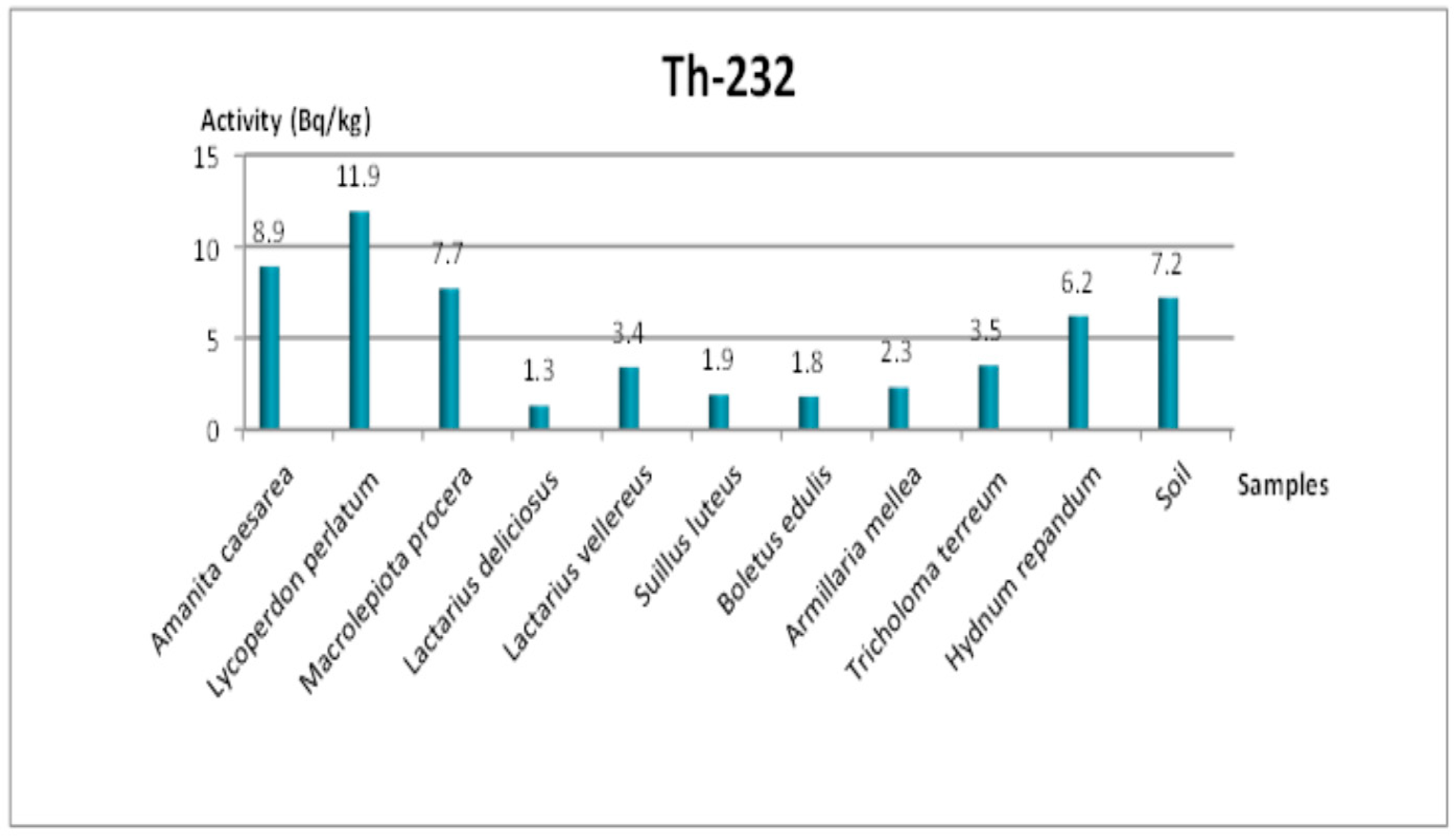
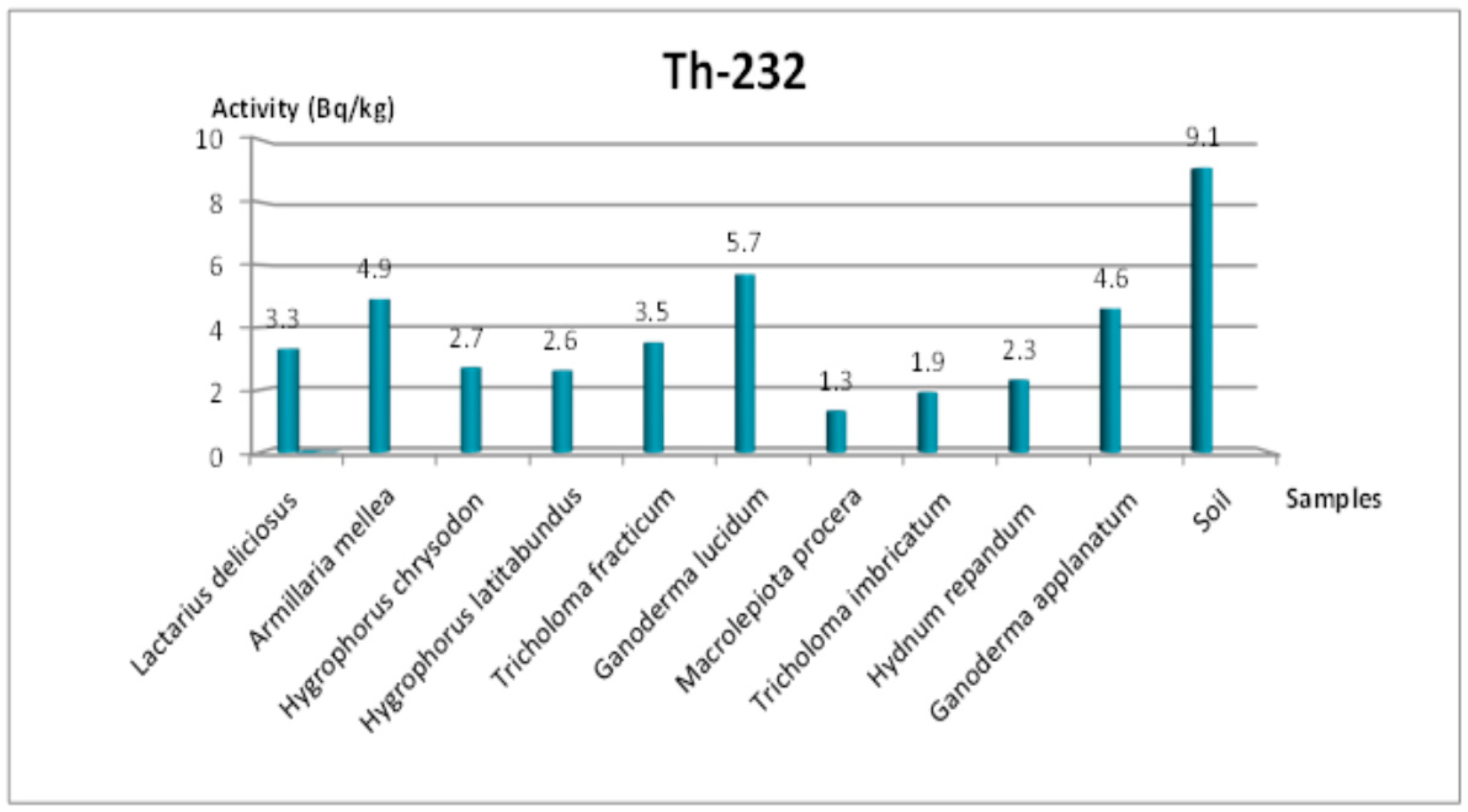
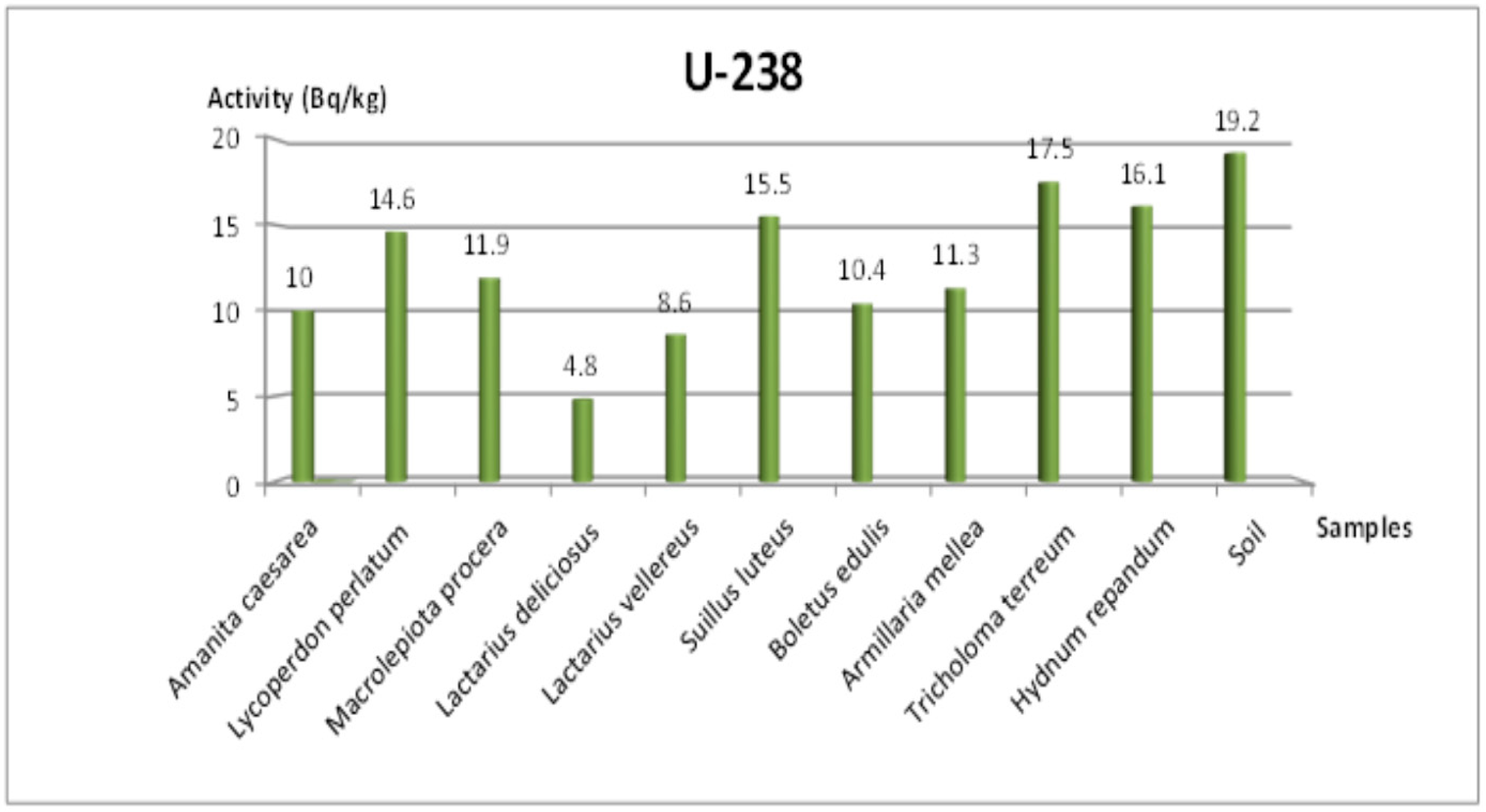

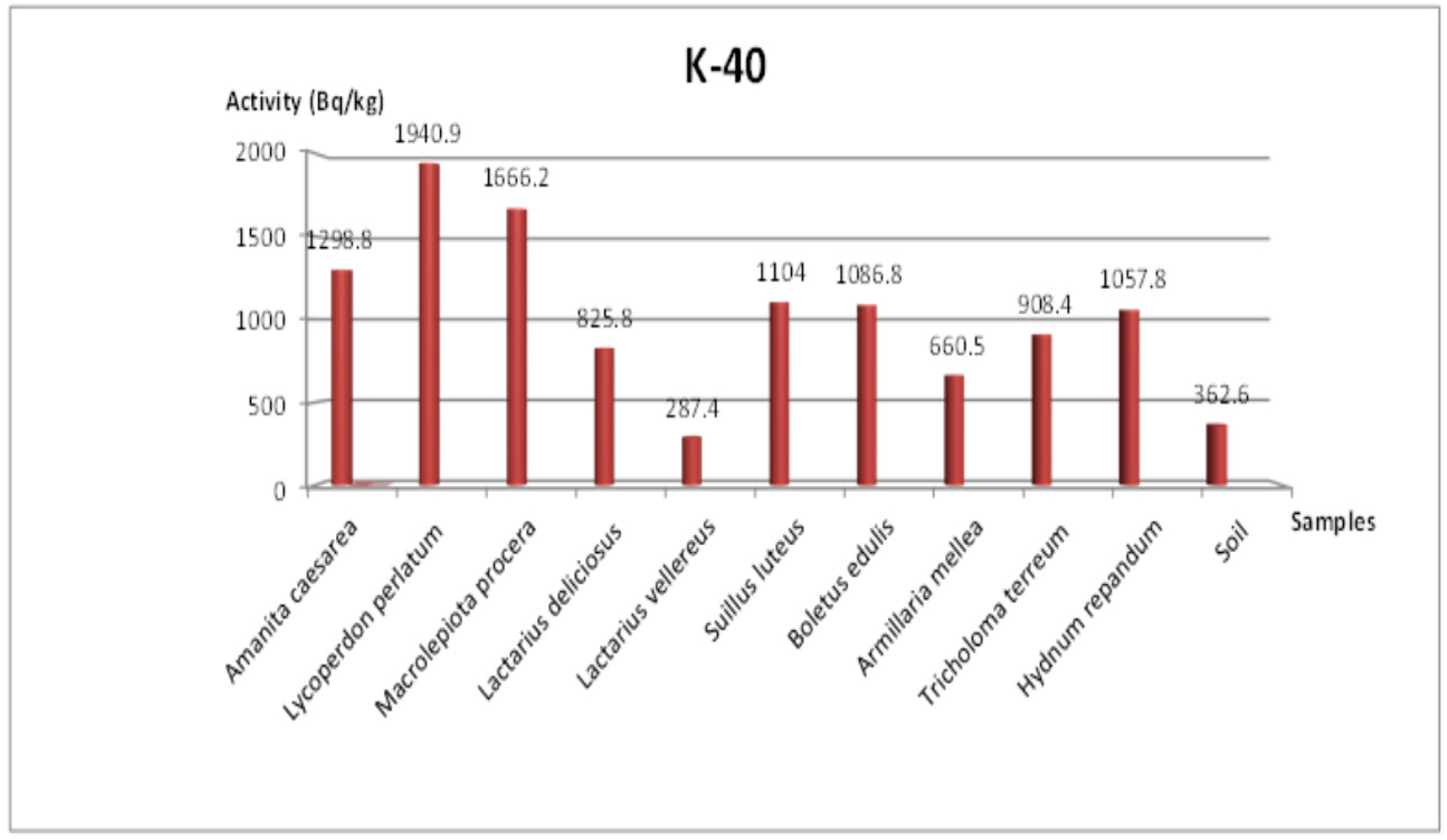
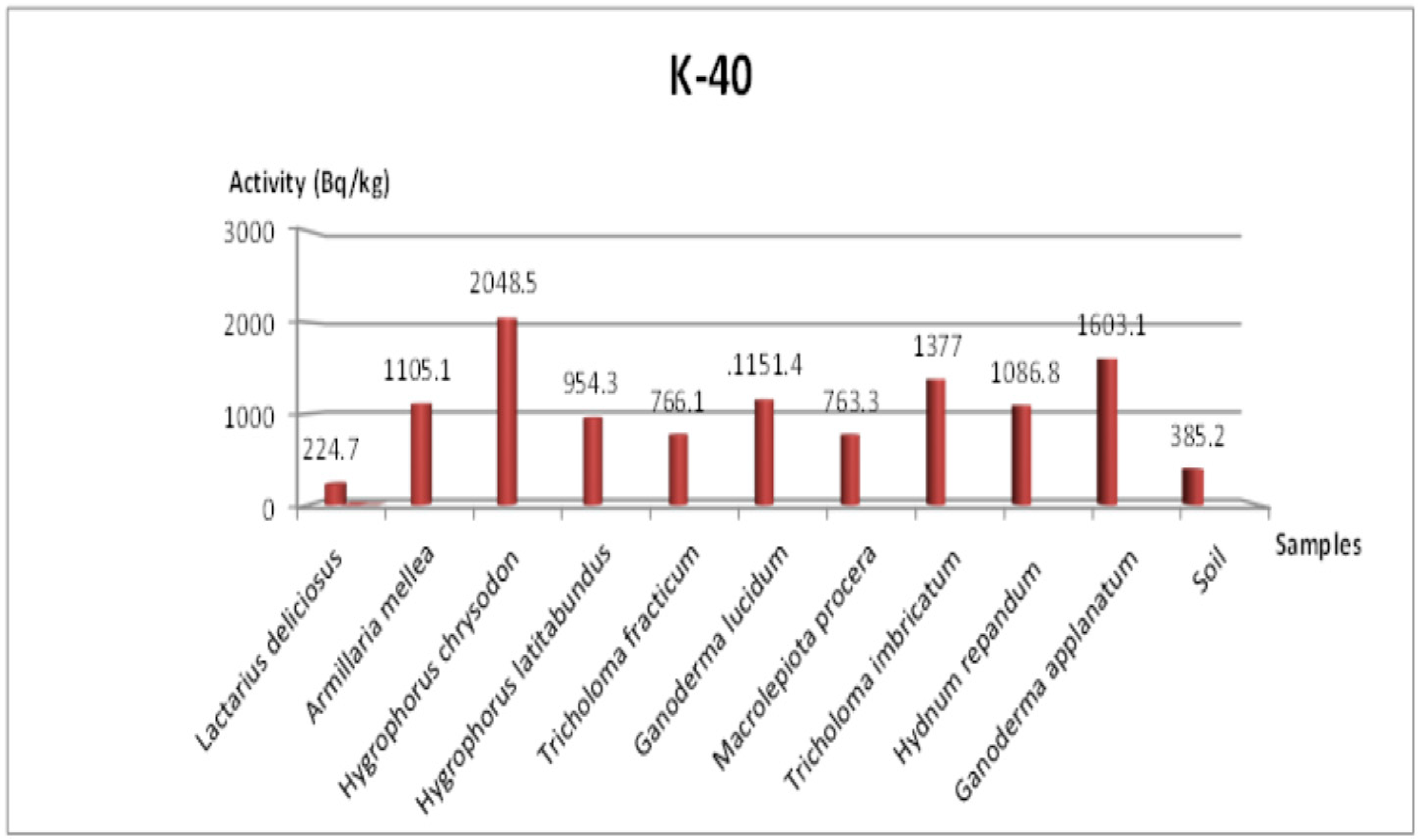
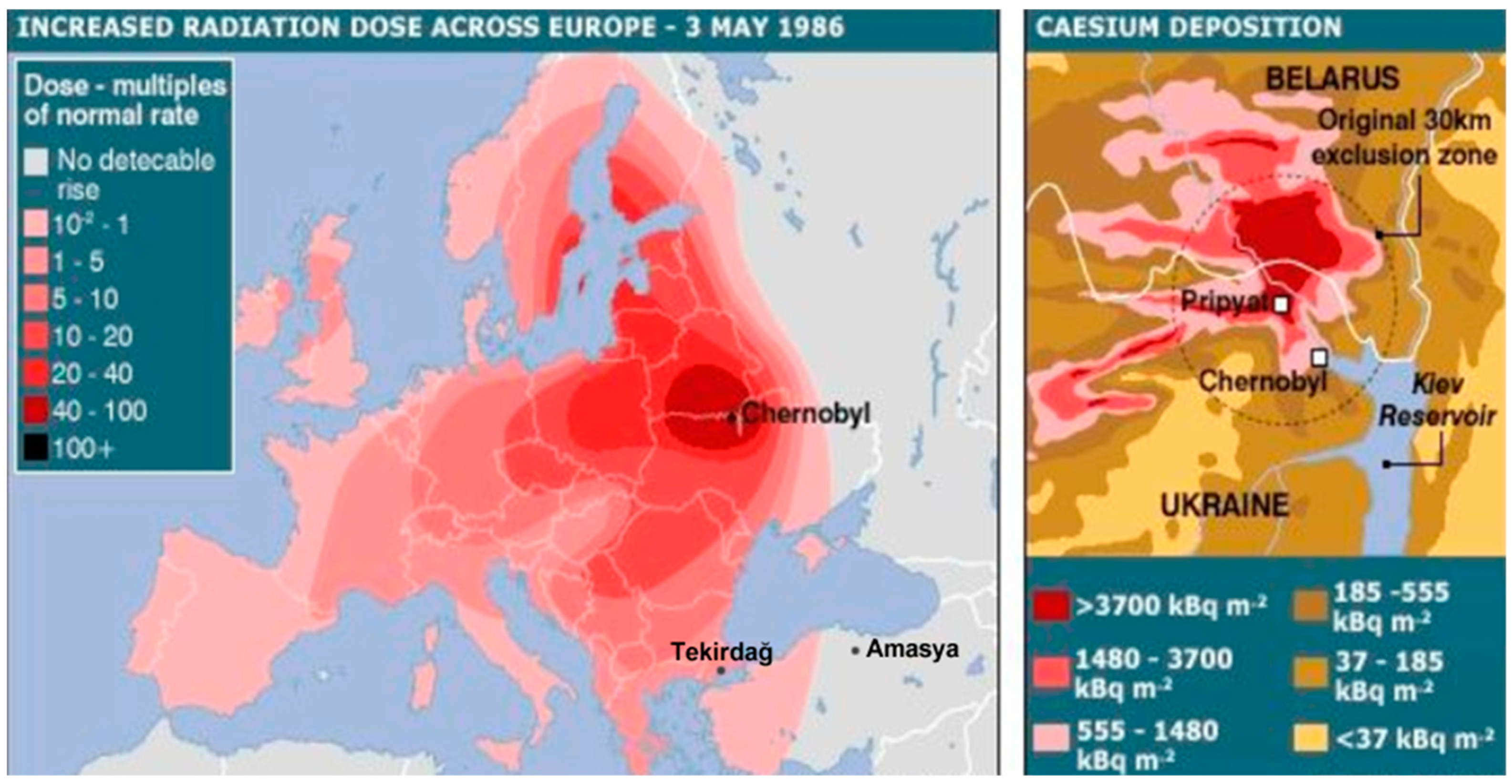
| Tekirdağ Province | Amasya Province |
|---|---|
| Amanita caesarea (Scop.) Pers | Lactarius deliciosus (L.) Grey |
| Lycoperdon perlatum Pers. | Armillaria mellea (Vahl) P. Kumm. |
| Macrolepiota procera (Scop.) Singer | Hygrophorus chrysodon (Batsch) Fr. |
| Lactarius deliciosus (L.) Grey | Hygrophorus latitabundus Britzelm. |
| Lactarius vellereus (Fr.) Fr. | Tricholoma fracticum (Britzelm.) Kreisel |
| Suillus luteus (L.) Roussel | Ganoderma lucidum (Curtis) P. Karst |
| Boletus edulis Bull. | Macrolepiota procera (Scop.) Singer |
| Armillaria mellea (Vahl) P. Kumm. | Tricholoma imbricatum (Fr.) P. Kumm |
| Tricholoma terreum (Schaeff.) P. Kumm | Hydnum repandum (L.) |
| Hydnum repandum L. | Ganoderma applanatum Pers. |
| Isotope | Energy (keV) | Half-Life (Days) | Abundance (%) |
|---|---|---|---|
| 133Ba | 81 | 3830 | 33 |
| 109Cd | 88 | 464 | 3.72 |
| 57Co | 122.1 | 271 | 86 |
| 57Co | 136.5 | 271 | 11 |
| 133Ba | 276.4 | 3830 | 6.9 |
| 133Ba | 302.8 | 3830 | 19 |
| 133Ba | 356 | 3830 | 62 |
| 133Ba | 383.8 | 3830 | 8.7 |
| 22Na | 511 | 946 | 180 |
| 137Cs | 661.6 | 11,022 | 85 |
| 54Mn | 834.8 | 313 | 100 |
| 60Co | 1173.2 | 1922 | 100 |
| 22Na | 1274.5 | 946 | 100 |
| 60Co | 1332.5 | 1922 | 100 |
| Species | 238U (Bq/kg) | 232Th (Bq/kg) | 40K (Bq/kg) | 137Cs (Bq/kg) |
|---|---|---|---|---|
| Amanita caesarea | 10.0 ± 0.3 | 8.9 ± 0.3 | 1298.8 ± 51.8 | 3.9 ± 0.1 |
| Lycoperdon perlatum | 14.6 ± 0.4 | 11.9 ± 0.3 | 1940.9 ± 77.4 | 11.5 ± 0.3 |
| Macrolepiota procera | 11.9 ± 0.4 | 7.7 ± 0.2 | 1666.2 ± 66.2 | 18.2 ± 0.4 |
| Lactarius deliciosus | 4.8 ± 0.1 | 1.3 ± 0.1 | 825.8 ± 32.9 | 5.2 ± 0.2 |
| Lactarius vellereus | 8.6 ± 0.3 | 3.4 ± 0.1 | 287.4 ±11.1 | 18.9 ± 0.4 |
| Suillus luteus | 15.5 ± 0.4 | 1.9 ± 0.1 | 1104.0 ± 42.5 | 31.0 ± 0.8 |
| Boletus edulis | 10.4 ± 0.3 | 1.8 ± 0.1 | 1086.8 ± 41.6 | 12.6 ± 0.4 |
| Armillaria mellea | 11.3 ± 0.3 | 2.3 ± 0.1 | 660.5 ± 26.1 | 5.1 ± 0.1 |
| Tricholoma terreum | 17.5 ± 0.4 | 3.5 ± 0.1 | 908.4 ± 35.8 | 127.8 ± 3.3 |
| Hydnum repandum | 16.1 ± 0.4 | 6.2 ± 0.2 | 1057.8 ± 42.1 | 115.7 ± 2.8 |
| Species | 238U (Bq/kg) | 232Th (Bq/kg) | 40K (Bq/kg) | 137Cs (Bq/kg) |
|---|---|---|---|---|
| Lactarius deliciosus | 3.3 ± 0.1 | 7.8 ± 0.2 | 224.7 ± 8.9 | 35.2 ± 0.9 |
| Armillaria mellea | 4.9 ± 0.1 | 14.3 ± 0.4 | 1105.1 ± 44.1 | 24.1 ± 0.3 |
| Hygrophorus chrysodon | 2.7 ± 0.1 | 9.6 ± 0.3 | 2048.5 ± 81.5 | 12.7 ± 0.4 |
| Hygrophorus latitabundus | 2.6 ± 0.1 | 8.2 ± 0.3 | 954.3 ± 38.4 | 8.6 ± 0.2 |
| Tricholoma fracticum | 3.5 ± 0.1 | 9.9 ± 0.3 | 766.1 ± 30.2 | 16.9 ± 0.4 |
| Ganoderma lucidum | 5.7 ± 0.2 | 7.4 ± 0.2 | 1151.4 ± 46.1 | 9.4 ± 0.2 |
| Macrolepiota procera | 1.3 ± 0.1 | 6.5 ± 0.2 | 763.3 ± 30.2 | 3.1 ± 0.1 |
| Tricholoma imbricatum | 1.9 ± 0.1 | 16.0 ± 0.5 | 1377.0 ± 54.7 | 63.7 ± 1.6 |
| Hydnum repandum | 2.3 ± 0.1 | 8.4 ± 0.3 | 1587.9 ± 63.3 | 13.4 ± 0.4 |
| Ganoderma applanatum | 4.6 ± 0.1 | 15.8 ± 0.4 | 1603.1 ± 63.8 | 18.3 ± 0.4 |
| Average | 3.28 | 10.39 | 1158.14 | 20.54 |
| Soil | 9.1 ± 0.3 | 12.5 ± 0.3 | 385.2 ± 15.2 | 23.1 ± 0.5 |
| Species | 238U (Bq/kg) | 232Th (Bq/kg) | 40K (Bq/kg) | 137Cs (Bq/kg) | Locality |
|---|---|---|---|---|---|
| Macrolepiota procera | 6.5 ± 0.2 | 1.3 ± 0.1 | 763.3 ± 30.2 | 3.1 ± 0.1 | Amasya |
| Macrolepiota procera | 11.9 ± 0.4 | 7.7 ± 0.2 | 1666.2 ± 66.2 | 18.2 ± 0.4 | Tekirdağ |
| Lactarius deliciosus | 7.8 ± 0.2 | 3.3 ± 0.1 | 224.7 ± 8.9 | 35.2 ± 0.9 | Amasya |
| Lactarius deliciosus | 4.8 ± 0.1 | 1.3 ± 0.1 | 825.8 ± 32.9 | 5.2 ± 0.2 | Tekirdağ |
| Hydnum repandum | 8.4 ± 0.3 | 2.3 ± 0.1 | 1587.9 ± 63.3 | 13.4 ± 0.4 | Amasya |
| Hydnum repandum | 16.1 ± 0.4 | 6.2 ± 0.2 | 1057.8 ± 42.1 | 115.7 ± 2.8 | Tekirdağ |
| Soil | 12.5 ± 0.3 | 9.1 ± 0.3 | 385.2 ± 15.2 | 23.1 ± 0.5 | Amasya |
| Soil | 19.2 ± 0.5 | 7.2 ± 0.2 | 362.6 ± 14.3 | 2.3 ± 0.1 | Tekirdağ |
| Countries | 137Cs (Bq/kg) | Year | Reference |
|---|---|---|---|
| Italy | 10.33–732.29 | 2001 | [27] |
| Slovakia | 322.9–869.6 | 2005 | [17] |
| Poland | 330–16,670 | 2006 | [29] |
| Slovakia | 2.4–720 | 2006 | [18] |
| Czech Rep. | 0.4–708 | 2006 | [18] |
| Türkiye | 27.2–28.4 | 2007 | [20] |
| Brazil | 1.45–10.6 | 2012 | [2] |
| Türkiye (Ordu-Kastamonu) | - | 2014 | [19] |
| Türkiye (Orta Karadeniz) | <0.01–697 | 2018 | [30] |
| Türkiye (Trabzon) | - | 2019 | [31] |
| Bulgaria | 98–124 | 2020 | [32] |
| Türkiye (Amasya-Tekirdağ) | 3.1–127.8 | 2021 | This study |
Disclaimer/Publisher’s Note: The statements, opinions and data contained in all publications are solely those of the individual author(s) and contributor(s) and not of MDPI and/or the editor(s). MDPI and/or the editor(s) disclaim responsibility for any injury to people or property resulting from any ideas, methods, instructions or products referred to in the content. |
© 2025 by the authors. Licensee MDPI, Basel, Switzerland. This article is an open access article distributed under the terms and conditions of the Creative Commons Attribution (CC BY) license (https://creativecommons.org/licenses/by/4.0/).
Share and Cite
Akkaya, A.; Aktaş, S. Radioactive Contaminants in Edible Mushrooms: A Comparative Study of 137Cs and Natural Radionuclides in Amasya and Tekirdağ, Türkiye. J. Fungi 2025, 11, 351. https://doi.org/10.3390/jof11050351
Akkaya A, Aktaş S. Radioactive Contaminants in Edible Mushrooms: A Comparative Study of 137Cs and Natural Radionuclides in Amasya and Tekirdağ, Türkiye. Journal of Fungi. 2025; 11(5):351. https://doi.org/10.3390/jof11050351
Chicago/Turabian StyleAkkaya, Afife, and Sinan Aktaş. 2025. "Radioactive Contaminants in Edible Mushrooms: A Comparative Study of 137Cs and Natural Radionuclides in Amasya and Tekirdağ, Türkiye" Journal of Fungi 11, no. 5: 351. https://doi.org/10.3390/jof11050351
APA StyleAkkaya, A., & Aktaş, S. (2025). Radioactive Contaminants in Edible Mushrooms: A Comparative Study of 137Cs and Natural Radionuclides in Amasya and Tekirdağ, Türkiye. Journal of Fungi, 11(5), 351. https://doi.org/10.3390/jof11050351






